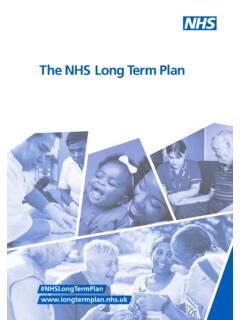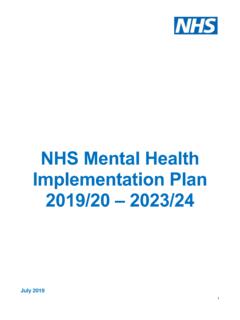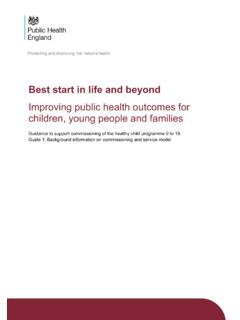Transcription of Interim NHS People Plan - NHS Long Term Plan
1 Interim NHS People plan 1 2 3 4 5 6 Contents Introduction .. 2 . Making the NHS the best place to work .. 9 . Improving the leadership culture .. 14 . Tackling the nursing challenge .. 20 . Delivering 21st century care .. 32 . A new operating model for 55 . Developing the full People plan .. 63 Other resources .. 65 1 | Contents Introduction In January this year, the NHS published its Long Term plan which sets out an ambitious 10-year vision for healthcare in England. It sets out a new service model: where we take more action on prevention and health inequalities, where we improve quality of care and health outcomes across all major health conditions, where the NHS harnesses technology to transform services, and where we get the most out of taxpayers investment.
2 Underpinning this vision is an NHS that ensures our People get the backing they need. This Interim People plan sets out our vision for People who work for the NHS to enable them to deliver the NHS Long Term plan , with a focus on the immediate actions we need to take. Our patients and service users across England are served by million dedicated staff working in the NHS and in NHS-commissioned services. They in turn work alongside millions of dedicated staff working in social care, public health services and the voluntary sector. Demand for health and care services is growing as a result of a growing and ageing population and the ever-increasing possibilities of medical science. To meet that demand and deliver the vision set out in the NHS Long Term plan , we will need more People working in the NHS over the next 10 years across most disciplines and in some new ones yet to be fully defined with a rich diversity of roles and jobs across all settings.
3 But more of the same will not be enough to deliver the promise of the NHS Long Term plan . We need different People in different professions working in different ways. We also need to address the cultural changes that are necessary to build a workforce that befits a world-class 21st century healthcare system. We need to promote positive cultures, build a pipeline of compassionate and engaging leaders and make the NHS an agile, inclusive and modern employer if we are to attract and retain the People we need to deliver our plans. We also need to transform the way our entire workforce, including doctors, nurses, allied health professionals (AHPs), pharmacists, healthcare scientists, dentists, non-clinical professions, social workers in the NHS, commissioners, non-executives and volunteers, work together. 1 work will be much more multidisciplinary, People 1 When referring to People and staff in this Interim People plan , we mean all these groups as well as the significant number of People working in other roles and professions who together make up our million workforce.
4 2 | Introduction will be able to have less linear careers, and technology will enable our People to work to their full potential as routine tasks (and some more complex ones) are automated. Improved technology will also mean that services are organised and delivered more efficiently, which will contribute to improved productivity. We need to do this because our patients and service users demand that we work in a more joined-up way; our People want to have more flexible careers and a better work /life balance; and taxpayers need us to find more efficient ways of working so that the growing demand for health and social care is affordable for society as a whole. This Interim People plan lays the foundations we need to make this a reality.
5 We begin with how to make the NHS the best place to work and how creating a better leadership culture is critical to that change. We have approached this work by modelling the changes we want to see, working collaboratively as a multiprofessional and multidisciplinary team. We have worked from the outset on the basis that multiprofessional clinical teams will be the foundation of the future workforce, rather than treating the workforce as a group of separate professions. There will undoubtedly need to be growth in all the established professions and in some new professions to meet future demand. We need, however, to take urgent, accelerated action to tackle nursing vacancies, especially in primary and community, mental health and learning disability settings. We are committed to advancing equality of opportunity and working productively with key stakeholders across the protected characteristics.
6 The Interim People plan is structured by these themes: 1. Making the NHS the best place to work The highly committed and dedicated People working for the NHS provide an extraordinary range of health and care services for patients and citizens. There is compelling evidence that the more engaged our People , the more effective and productive they are, and most importantly, the higher the quality of care they deliver to our patients. Our patients know that to be true they tell us clearly that they want the staff who look after them to be well cared for themselves. 3 | Introduction Yet our People report growing pressure, frustration with not having enough time with patients, and rising levels of bullying and harassment. Our Black and Minority Ethnic (BME) staff, in particular, report some of the poorest workplace experiences (2018 national NHS Staff Survey).
7 Sickness absence in the NHS runs around percentage points higher than in the rest of the economy and around one in eleven of our staff leave the NHS entirely every year. Our NHS Staff Survey provides valuable data that will inform the development of work in this area. To serve our patients and citizens in the best way possible we must improve the experience of our People . At every level we need to pay much greater attention to why many of them leave the NHS, taking decisive action in both the short and medium term to retain existing staff and attract more People to join. This isn t just a job for national leadership, important as that is. It is incumbent on every single NHS organisation to pay much greater attention to improving the experience of working in the NHS. To deliver the promise set out in the NHS Long Term plan we need to make the NHS, already the largest employer in England, also the best.
8 This Interim plan sets out our vision and immediate actions to make the NHS the best place to work . 2. Improving our leadership culture Our leaders play a key role in shaping the culture of NHS organisations. All NHS leaders, in both providers and commissioners, need to focus on developing a positive, inclusive and People -centred culture that engages and inspires all our People and with a clear focus on improvement and advancing equality of opportunity. Where leaders focus on developing, engaging and supporting their People to improve services for patients and citizens, the quality, financial and performance metrics also improve. It is no coincidence that those trusts with good and outstanding use of resources ratings also have good and outstanding well-led ratings, demonstrating the strong relationship between greater productivity and more engaged staff.
9 In these organisations, staff are engaged by a shared purpose and motivated to work more efficiently and effectively improving patient experience, reducing waste and redesigning care. This Interim plan addresses how we develop and spread a positive, inclusive, person-centred leadership culture across the NHS. 4 | Introduction 3. Addressing urgent workforce shortages in nursing There are shortages across a wide range of NHS staff groups doctors, including GPs and psychiatrists, paramedics, radiographers, genomic scientists and dentists, to name a few that we are committed to addressing. However, the most urgent challenge is the current shortage of nurses, who are critical to delivering the 21st century care set out in the NHS Long Term plan .
10 We must act now to support and retain our existing nurses, significantly increase the number of newly qualified nurses joining the NHS, bring in nurses from abroad and ensure we make the most of the nurses we already have. This Interim plan sets out the key actions required in the short and medium term to build the nursing workforce we need for the future. 4. Delivering 21st century care Over the next 10 years, health and care will change significantly. We have a roadmap in the NHS Long Term plan which sets out a new service model for the 21st century: increasing care in the community; redesigning and reducing pressure on emergency hospital services; more personalised care; digitally enabled primary and outpatient care; and a focus on population health and reducing health inequalities. The NHS Long Term plan also identifies areas where earlier diagnosis, new and integrated models of care, and better use of technology offer the potential to significantly improve population health and patient care.











